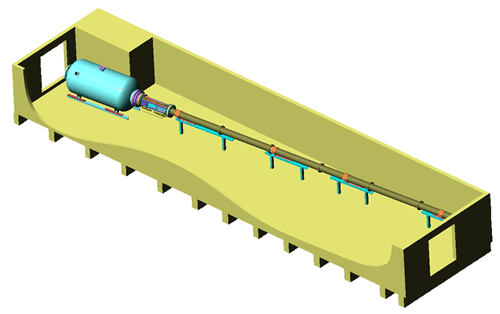
Ludwieg tube
Encyclopedia

Principle
A Ludwieg tube is a wind tunnelWind tunnel
A wind tunnel is a research tool used in aerodynamic research to study the effects of air moving past solid objects.-Theory of operation:Wind tunnels were first proposed as a means of studying vehicles in free flight...
that produces supersonic flow for short periods of time. A large evacuated dump tank is separated from the downstream end of a convergent-divergent nozzle by a diaphragm or fast acting valve. The upstream end of the nozzle connects to a long cylindrical tube, whose cross-sectional area is significantly larger than the throat area of the nozzle. Initially, the pressure in the nozzle and tube is high. To start the tunnel, the diaphragm is ruptured, e.g., by piercing it with a suitable cutting device, or opening the valve respectively. As always when a diaphragm ruptures, a shock wave
Shock wave
A shock wave is a type of propagating disturbance. Like an ordinary wave, it carries energy and can propagate through a medium or in some cases in the absence of a material medium, through a field such as the electromagnetic field...
propagates into the low-pressure region (here the dump tank) and an expansion wave propagates into the high-pressure region (here the nozzle and the long tube). As this unsteady expansion propagates through the long tube, it sets up a steady subsonic
Speed of sound
The speed of sound is the distance travelled during a unit of time by a sound wave propagating through an elastic medium. In dry air at , the speed of sound is . This is , or about one kilometer in three seconds or approximately one mile in five seconds....
flow toward the nozzle, which is accelerated by the convergent-divergent nozzle to a supersonic
Supersonic
Supersonic speed is a rate of travel of an object that exceeds the speed of sound . For objects traveling in dry air of a temperature of 20 °C this speed is approximately 343 m/s, 1,125 ft/s, 768 mph or 1,235 km/h. Speeds greater than five times the speed of sound are often...
condition. The flow is steady until the expansion, having been reflected from the far end of the tube, arrives at the nozzle again. For practical reasons, flow times are about 100 milliseconds for most Ludwieg tubes. For many purposes, this flow duration is sufficient. However, by taking advantage of multiple quasi-static flows between expansion wave reflections, experimentation times of up to 6 seconds can be achieved.
History
The Ludwieg Tube was invented by Hubert Ludwieg (1912-2000) in 1955 in response to a competition for a transonicTransonic
Transonic speed is an aeronautics term referring to the condition of flight in which a range of velocities of airflow exist surrounding and flowing past an air vehicle or an airfoil that are concurrently below, at, and above the speed of sound in the range of Mach 0.8 to 1.2, i.e. 600–900 mph...
or supersonic
Supersonic
Supersonic speed is a rate of travel of an object that exceeds the speed of sound . For objects traveling in dry air of a temperature of 20 °C this speed is approximately 343 m/s, 1,125 ft/s, 768 mph or 1,235 km/h. Speeds greater than five times the speed of sound are often...
wind tunnel
Wind tunnel
A wind tunnel is a research tool used in aerodynamic research to study the effects of air moving past solid objects.-Theory of operation:Wind tunnels were first proposed as a means of studying vehicles in free flight...
design that would be capable of producing high Reynolds number at low operating cost. Professor Ludwieg was also responsible for the experimental demonstration and explanation of the large effect of sweep on the drag of transonic
Transonic
Transonic speed is an aeronautics term referring to the condition of flight in which a range of velocities of airflow exist surrounding and flowing past an air vehicle or an airfoil that are concurrently below, at, and above the speed of sound in the range of Mach 0.8 to 1.2, i.e. 600–900 mph...
wings (his dissertation in 1937).

